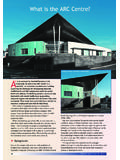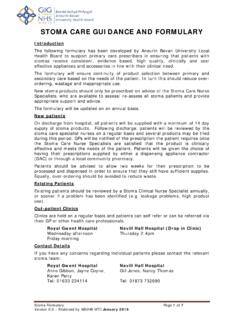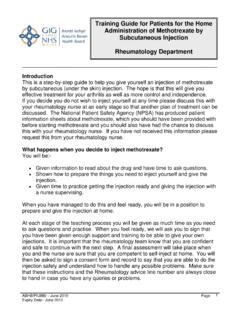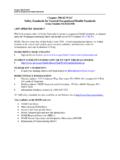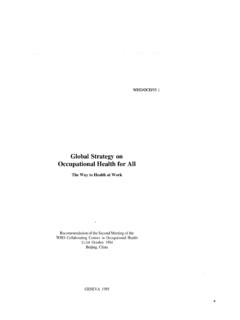Transcription of National occupational standards for the practice of public ...
1 Better SkillsBetter JobsBetter HealthNational occupational standards for thepractice of public health guide March 2004 Skills for health , Guide to the National occupational standards for the practice of public health , March 200402 These National occupational standards describegood practice in the practice of public health . Thestandards have been developed as a means ofimproving the capacity and capability of the publichealth workforce. The standards make the linksbetween what needs to happen to improve people shealth and what individuals need to do to contributeto this effort effectively.
2 These standards have beendesigned to be used across service, organisationaland individual levels across all sectors - to developservices, plan workforces, guide practice and themanagement of people, and form the basis ofeducation, training and qualifications. Many practitioners and agencies willingly gave theirexpertise and time in the development of thesenational occupational standards . Without theircontribution it would not have been possible toproduce these standards nor have taken forwardthis work on a multi-agency and multi-disciplinarybasis. The standards were approved as UK-wide nationaloccupational standards by the education regulatoryauthorities the Qualifications and CurriculumAuthority (QCA) and the Scottish QualificationsAuthority in February 2004.
3 This approval atteststo the quality of these standards and theirappropriateness for all who contribute to improvingthe health of the public , wherever they work andwhatever their work role. The project to produce these National occupationalstandards was led by Skills for health , the UK-wideSector Skills Council for health . The project wascommissioned and overseen by the four UK HealthDepartments. In addition a Core StakeholdersGroup, including representatives of regulatorybodies and professional bodies as well as the fourgovernment health departments, advised on theprocesses and outcomes of the work.
4 The team ofindependent consultants who produced theoutcomes were: Lindsay Mitchell of Prime R&D,Thelma Harvey and Barbara contribution of the many individuals andagencies involved in the development of thesestandards is gratefully acknowledged. March 2004 Acknowledgements Introduction01 What are the National occupational standards for the practice of public health ?05 Why were the standards developed?05 Who do the National occupational standards apply to?05 What are the benefits of the standards ?05 How can the standards be used?05 What are the National occupational standards like?
5 05 How do the standards relate to the standards for public health specialists?05 Who oversaw the development of the standards ?05 When were the standards developed?0502 What is covered by the standards for the practice of public health ?06 What is public health ?06 What do the National occupational standards cover?07 Who is involved in improving the health of the public ?0903 What do the standards for the practice of public health look like?10 How are the National occupational standards structured?10 What is included in the National occupational standards for public health ?
6 1004 How can the National occupational standards be applied?2105 How can the National occupational standards for the practice of public health be used?22 Who will use the National occupational standards ?22 What are the benefits of these National occupational standards ?22 How do these National occupational standards relate to other competences/frameworks?22 What are the different uses of the standards ?23 Have you any examples of how the standards have been used?2606 How can I provide feedback on the National occupational standards ?4207 What is on the CD-Rom?
7 43 Appendix A Example of the structure of a National occupational standard44 ContentsSkills for health , Guide to the National occupational standards for the practice of public health , March 200403 Skills for health , Guide to the National occupational standards for the practice of public health , March 200404 health is more than the absence of disease andbeing healthy is a positive state of wellbeing, onewhich is promoted through broad engagement ofmany groups and interests within society. To behealthy requires individuals to engage in their healthas much as it requires healthy and sustainableenvironments and well trained professionals.
8 DerekWanless recognised this when he said in his report: Adequate workforce capacity will need to becreated with appropriately broad skill more of the activity will be concernedwith monitoring, interpreting data, identifying risk,educating people and motivating them to changebehaviour, the required mix of skills will change. Derek Wanless, Securing Good health for theWhole Population: Final Report, February 2004 The publication of National occupational standardsfor public health is a timely response to the growinginterest in health and wellbeing and the challenge ofdeveloping the workforce to promote health andaddress the challenges of health inequalities.
9 Thepublic health workforce needs to include a diversemix of people from different professional andpractice backgrounds working across all sectors ofthe economy education, transport, housing,agriculture, and the environment. Some will workdirectly in the health sector; the work of others willindirectly impact on health . Whatever thebackground, the occupational standards for thepractice of public health have been designed toassist with developing services, planningworkforces, guiding practice and managing form the basis of education, training andqualifications, making links between practice andimpact on health .
10 The standards arecomplementary to the standards for with any developing area, these nationaloccupational standards for the practice of publichealth are not set in stone but provide a startingpoint. Feedback of your views will help us refinethem in the light of experience and practice , and wehope that they will be a useful tool to support broadengagement in improving health for all populations,particularly the vulnerable and excluded. Sian GriffithsPresident of the Faculty of public HealthIntroductionSkills for health , Guide to the National occupational standards for the practice of public health , March 2004 Why were the standards developed?




